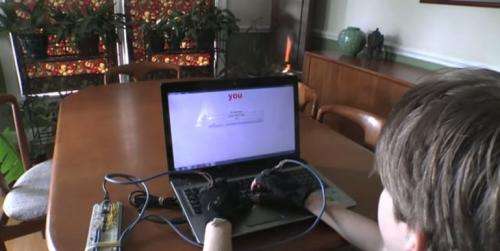August 31, 2014 weblog
DIY glove-based tutor indicates muscle-memory potential

A senior editor at IEEE Spectrum worked on a DIY project that enabled his 11-year-old son to improve his touch typing by use of a vibrating glove. His son was already "pretty quick on the keyboard," said his father, David Schneider, but his finger technique could have used some more training. Schneider tried making a glove to serve as a training tool. Eight vibration motors were sewn into the fingers of cycling gloves. He programmed the Arduino to activate a given motor for a quarter of a second corresponding to each character he sent to the microcontroller's serial port—"a "1" would vibrate the motor pressing on the left pinkie, a "2" for the left ring finger, a "3" for the left middle finger, and so forth." He had to write a program that could run on a laptop for his son to associate the stimulation of the fingers with the correct sequence of keystrokes. He chose Tkinter, Python's de-facto standard Graphical User Interface package. The program presented a word and showed the word spelled out on the screen. It sent the appropriate character to the Arduino so that the corresponding finger was vibrated.
As the program is designed, a user can see what he or she is typing. A button allows the person to advance to another word. "Python and Tkinter made all this easy enough to program with less than 200 lines of code," said Schneider. Was this effort a success? Schneider said, "he reported that spending a few minutes getting his fingers vibrated indeed helped him to get the sequence of keystrokes right." Schneider also said, "There's a slider for the user to vary the rate at which the program spews out letters," and his son "was more inclined to play with the slider, trying to challenge himself to keep up with rapid-fire bursts of letters. Clearly, I had missed a critical concept in modern pedagogy: gamification."
This DIY project is nonetheless noteworthy as one more instance of what interesting and helpful applications might be possible with wearable computers. Earlier this year, IEEE Spectrum had a story about the work of Caitlyn Seim, a Ph.D student who showed Schneider's colleague a haptic glove; inside each of the five finger holes she had sewn a flat vibration motor. The five vibrators were wired to a microcontroller on the back of the hand. Schneider wrote that "my colleague Ariel Bleicher visited Thad Starner's lab at Georgia Tech and tried out an intriguing kind of wearable technology: a computerized glove equipped with five vibration motors, one perched atop each finger. Wearing the glove for a couple of hours while attending to other tasks, she acquired sufficient 'muscle memory' to play 61 notes of Beethoven's 'Ode to Joy' with hardly any effort."
Seim is conducting research focused on how to apply wearable, tactile interfaces to facilitate passive haptic learning and passive haptic rehabilitation. Earlier this year, Bleicher wrote in IEEE Spectrum that Starner and colleagues believe that the repeated buzzing from the glove creates a muscle memory that enables a wearer to learn to play a song with less practice than without haptic stimulation. "They have also studied the glove's effect on people with spinal cord injuries and found that it can help them regain some sensation and dexterity in their hands. The researchers are now beginning experiments to test whether haptic gloves can teach braille typing and stenography—evidence that the technology could impart not just patterns but also language."
More information: spectrum.ieee.org/geek-life/ha … clememory-programmer
© 2014 Tech Xplore
















